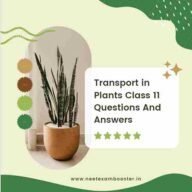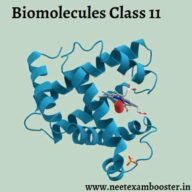Structural Organisation in Animal Class 11:- In the complex body of multicellular organisms some basic functions are performed by some different types of cells in an organised manner .Animals are made up of various different types of cells. Different organisms have different structural and functional organizations. The different cells combine to form tissues. A various number of tissues together form an organ, and different organs collectively form an organ system. The different types of tissues consist of – epithelial tissue, connective tissue, skeletal tissue, muscular tissue, and neural tissue.
Structural Organisation in Animal Class 11 Questions And Answers
Q.1. Name the sugar which is present in milk? How many units of monosaccharide does it contain?
A.1. In milk Lactose, a disaccharide sugar is present . It contains two types of monosaccharide units i.e D-glucose and D-galactose.
Q.2.Name the linkage which connects the monosaccharide unit in a polysaccharide?
A.2. β-1, 4’-glycosidic linkage connects the monosaccharide unit in a polysaccharides.
Q.3. Write the name of an invert sugar. Why is this called so?
A.3. Example of invert sugar is sucrose. It is known as an invert sugar because the hydrolysis inverts rotation of plane-polarized light.
Q.4. In which conditions glucose is converted into gluconic and saccharic acid?
A.4. With mild oxidizing agents such as bromine and water, it is converted into gluconic acid and it is oxidised.When it is oxidized with strong oxidizing agents such as HNO3, glucose is converted into saccharic acid.
Structural organisation in Animal Class 11 Quiz

Q.5. Match the following:
| Column I | Column II |
| Compound epithelium | Alimentary canal |
| Septal nephridia | Cockroach |
| Compound eyes | Skin |
| Typhlosole | Mosaic vision |
| Open circulatory system | Earthworm |
A.5. Compound epithelium- Skin,septal nephridia-earthworm ,Compound eyes- Mosaic vision ,Typhlosole- Alimentary canal ,Open circulatory system- Cockroach
Q.6. Write the cellular components of blood.
A.6. Blood contains the given components:
- Plasma
- Red Blood Cells
- White Blood Cells
- Platelets
Q.7. Write the functions and types of the nephridia in an earthworm.
A.7. Following are the Functions:
- The composition and volume of body fluids is regulated by the nephridia.
- Nephridia starts as a funnel that collects the excess amount of fluid from the coelomic chamber.
- It connects to tubular parts of nephridium and the waste is delivered to the surface through a pore.
Following are the types of Nephridia:
- Septal nephridia
- Pharyngeal nephridia
- Integumentary nephridia
Q.8. Write the functions of each of the following:
- Ureters in the frog.
- Malpighian tubules of cockroach.
- Body wall in the earthworm.
A.8.
- Ureters in frog– Sperms and excretory waste to the cloaca carry by ureters . It also carry the ova.
- Malpighian tubules- Each tubule is lined by glandular cells and carries out excretion. The excretory materials which are then converted into uric acid absorbed by the glandular cells .Thenit is released out through the hindgut.
- Body wall in Earthworm– It is comprises basal cells, receptor cells and gland cells. It provides support and the cells secrete mucus to keep the skin moist. The muscles provide strength and rigidity.
Q.9. Write a brief account of the circulatory system of earthworm.
A.9. The earthworm having a closed circulatory system,which consists of capillaries, blood vessels and heart. Due to the closed system the blood is confined to the heart and blood vessels. The smaller blood vessels supply to the gut, body wall and nerve cord. The 4th, 5th, and 6th segments contains blood, glands which produce blood cells and haemoglobin that dissolves in the plasma.
Q.10. In which region the following found in the animal body?
- Chondrocytes
- Axons
- Ciliated epithelium
A.10.
- Chondrocytes- Found in the cartilage of the connective tissue and secrete matrix.
- Axons- With a long distal end it is a long fibre. There is a bulb-like structure known as a synaptic knob at the end. It transmits nerve impulses away from the cells.
- Ciliated epithelium- It helps in the movement of particles or fluid over epithelial surface in structures such as the trachea, nasal cavities, bronchial tubes.
Q.11. Write the different cell junctions found in tissues.
A.11. The following cell junctions are found in tissues:
- Tight Junctions- Plasma membranes of adjacent epithelial cells are held close to each other.
- Gap Junctions- It facilitates the exchange of the chemicals between adjacent cells.
- Adhering Junctions- It helps in connecting the neighbouring cells together.
Q.12. Frogs are beneficial for mankind, how?
A.12. Frogs feed on the insects and protect the crops. It is an important link in the food chains and the food web in the ecosystem. Their limbs are also a source of food.
Q.13. In which region the hepatic caecum in a cockroach is located? Write it’s function?
A.13. At the junction of foregut and midgut the hepatic caecum is present .Digestive juices is secreted by it and helps in the digestion process.
Q.14. Write two identifying features of an adult male frog.
A.14. Followings are the features of an adult frog:
- Loose skin folds in the throat of a male frog called as vocal sacs. It produces a croaking sound.
- Copulatory pads present on the forelimb of the male frog are nuptial pads. They helps in closing the female during Amplexus.
Structural organisation in Animal Class 11 Toppers Notes
Q.15. Write in one line:
- The ovaries in a cockroach located in?
- How many number of spermathecae are present in an earthworm?
- How many number of segments does the abdomen of the cockroach contain?
A.15.
- 4th, 5th, and 6th abdominal segments present in an earthworm.
- There are four pairs of spermathecae in the 4th, 5th, and 6th abdominal segments.
- 3-7 segments present in the abdomen of the cockroach contain.
Q.16.Define connective tissue
A.16. Group of tissues composed of an extracellular matrix is collectively known as connective tissues. Examples of connective tissues,blood, bones, tendon, adipose, ligaments and areolar tissue. There are three different types of connective tissue:
- Fluid Connective Tissue.
- Fibrous Connective Tissue.
- Skeletal Connective Tissue.
Q.17. Write the name of organ which is present both in male and female cockroaches?
A.17. Anal cerci,is an essential sense organ i present in both male and female cockroaches.A pair of appendages present at end of the abdomen and functions by detecting vibrations and are wind sensitive.
Q.18. Define adipose tissue.
A.18. Adipose tissue is also known as the fat tissue.It is connective tissue composed of adipocytes and are primarily located beneath the skin. The main function of adipose tissue is to insulate the body and stores energy in the form of fat.
Q.19. Write the name the process by which a tadpole develops into an adult frog?
A.19. Metamorphosis is the process in which a tadpole turns into a frog.
Q.20. Write the common name of Periplaneta Americana?
A.20. Periplaneta Americana is the common name of American cockroach.
Structural organisation in Animal Class 11 Study Materials
Q.21. Write the cellular components of blood?
A.21. Cellular components found in blood are collectively known as blood corpuscles. There are three types of blood corpuscles are:
- Red blood corpuscles- RBC’s
- White blood corpuscles-WBC’s
- Blood Platelets
Q22.Write the function of Ureters in frog.
A.22. Frogs are amphibians which contains two ureters that emerge from the kidneys.
In males, the ureters act as a urogenital duct that opens into the cloaca.Helps in passing the urine as well as the sperm to the exterior. In females, ureters open separately in the cloaca and excrete only the urine.
Q.23. Define osteoclast and osteoblast?
A.23. It is the bone cells responsible for the dissolving of bones by removing the mineral matrix and the collagen part of the bone. It is the bone cells responsible for bone formation.
Q.24. Write the structural Organization of an animal
The structural organization of a multicellular animal is as follows:
Cells → Tissues → Organs → Organ system
Q.25. Write the functions of Muscular and Nervous tissue.
In the Locomotion and movement muscular tissues are involved whereas in control and coordination Nervous tissue plays an essential role.
Q.26. What are organs and the organ system?
The collection of tissue forms an organ and a group of organs that work together to do or perform one or more functions is called an organ system.
Q.27. Define Epithelial Tissues.
Membrane bounded tissues, which are composed of one or more layers of cells known as epithelial tissue. They play an important role in forming the covering of most internal and external surfaces of the body.
Q.28. Write the name of tissue that provides support and surface for attachment of muscle.
Skeletal connective Tissues. This tissue forms a frame network of the body and provides protection and rigidity to the various organs of the body.
Q.29. Write the types of neurons are there.
On the basis of functionality of the neurons, they are classified into three types:
- Sensory neurons or afferent neurons.
- Motor neurons or efferent neurons.
- Interneurons.
On the basis of structure, neurons are again classified into two types
- Bipolar neurons .
- Multipolar neurons .
Click here to join our telegram channel for more study materials like this (Structural Organisation in Animal Class 11)



















